From cannons to rockets to nuclear-armed ordinance, the F-89 seemed a formidably armed interceptor, protecting North America in the early years of the Cold War from Soviet bomber fleets coming over the polar region.
In the years following World War 2 the United States faced a new enemy, a power with a large military and continued large scale testing and development of nuclear weapons. That enemy was the Soviet Union. They tested their first atomic bomb in 1949. It was the beginning of the Cold War.
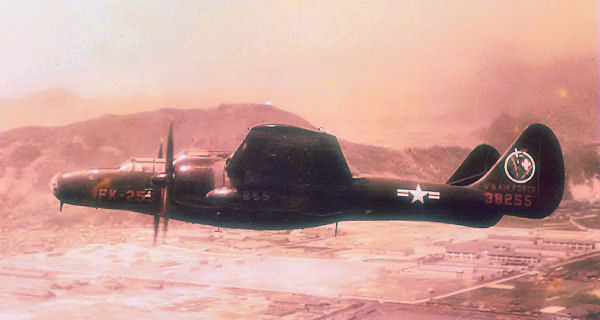
The age of the jet was also in its infancy, and the United States was caught with a holdover from World War 2 for air defense interceptor duties against enemy bombers. The Northrop P-61 Black Widow was a large, heavily armed, twin boom, twin engine prop plane. P-61’s served in both Europe and Asia with distinction as night fighters. Rugged and reliable as it was, speed and range would challenge the plane in the role of intercepting high altitude bombers coming across the North Pole.
The USAAF (United States Army Air Force), soon to be in 1947 USAF (United States Air Force), needed a new all-weather interceptor that was jet powered. After considering offerings from Curtis, Northrop, and Douglas, Northrop’s design was chosen. The two-seat plane was dubbed the “Scorpion” by Northrop employees due to the aircraft’s highly swept tail creating a stance similar to the arachnid. Designated the XF-89, the prototype first flew Aug. 16, 1948. A total of six variants would serve as all-weather interceptors from Alaska to Iceland.
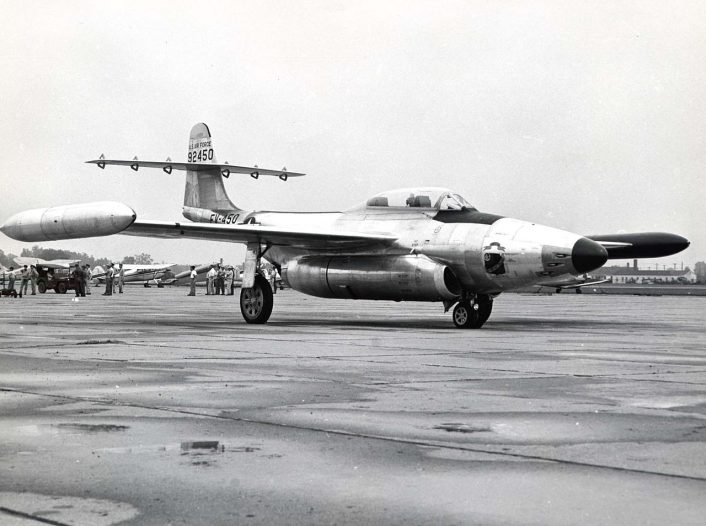
The F-89A and F-89B
Powered by two J35-A-21 engines and armed with six 20 mm cannon in the nose, the F-89A was the first version of the Scorpion to see service. It had underwing mounts for bombs and rockets and wingtip fuel tanks extending range. 48 of the A models were ordered but only 18 actually built, the remaining 30 were converted to the improved B model configuration. Most of the existing F-89A models were eventually brought up to the B configuration as well. The F-89B was essentially the same aircraft as the F-89A, the differences being new avionics were installed and eventually the planes received the more powerful J35-A-33 engines.
The F89C
A total of 164 of the F-89C version were delivered to the USAF. The C model had increased engine thrust over previous versions. Several F-89C’s disintegrated in mid-air causing the grounding of the entire fleet in 1952. A major structural redesign of the wing was initiated to solve the problems, and all F-89 aircraft went through a modification program. The F-89C had a top speed of 650 mph (1046 km/h) and a maximum range of 905 miles (1456 km).
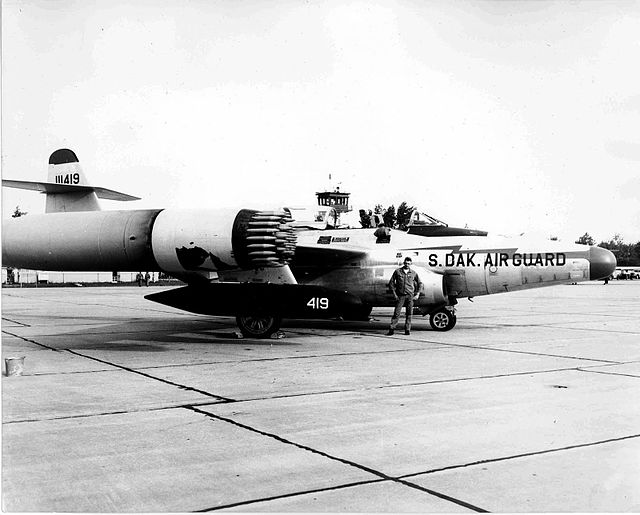
The F89D
The F-89D model had a new Hughes E-6 radar fire control system, guiding the aircraft toward the predicted position of the target automatically. However, this version carried no guns. Instead it was armed with 104 unguided 2.75 in (69 mm) “Mighty Mouse” rockets. Pods on each of the wingtips carried 52 rockets each in the frontal area, and aircraft fuel behind the ordinance. The rockets could be fired several different ways with the most potent being a salvo of all 104 rockets being released in under four-tenths of a second. Usually flying in pairs, the idea was to fly to the formations of enemy bombers and fire salvos into them, one rocket had enough explosive power to bring down a bomber. The F-89D was the most produced version of the Scorpion with 862 built. It had a maximum speed of 636 mph (1024 km/h), maximum range of 1,367 miles (2200 km), and a service ceiling of 49,200 ft.
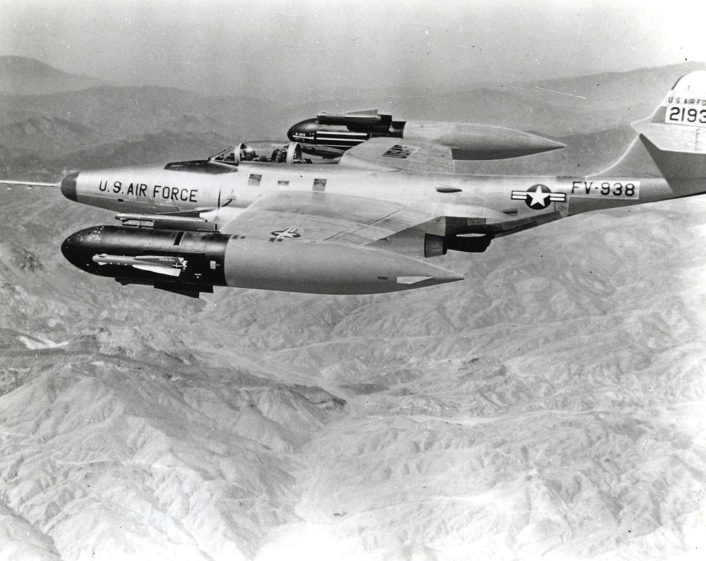
The F89H and F-89J
A solitary YF-89E was produced for engine testing. The F-89F and F-89G models were planned but never became a reality. Instead the F-89H was developed, carrying the newer Hughes E-9 fire control system. Armament changed again with the addition of three GAR-1 (Guided Aircraft Rocket) guided air-to-air missiles attached around the outer areas of each of the wingtip pods in retractable mechanisms. There were provisions to carry 21 of the 2.75 in unguided rockets in the pods as well. This Scorpion could also carry the new deadly unguided MB-1 Genie nuclear armed rocket. Two of these could be mounted to the aircraft, one under each wing. Close to 350 F-89D aircraft were upgraded with these armaments and re-designated the F-89J. This would be the final variant of the F-89.
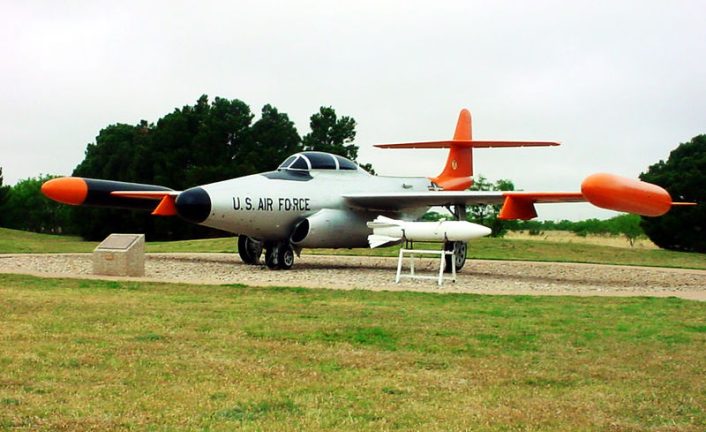
The Genie
Developed out of the fear of large armadas of Soviet bombers raining bombs on targets in the United States and throughout North America, the Genie was the first nuclear armed air-to-air rocket. The warhead was 1.5 kilotons and the range was 6 miles (9.6 km). The fireball upon detonation would be ¼ mile (0.8 km) wide. The rocket was over 9 ft (2.74 m) long and weighed 822 lb (373 kg). It flew at a maximum speed of Mach 3.3. The MB-1 designation was changed to AIR-2 (Air Intercept Rocket) in 1963. 3,150 Genies were produced, garnering the nickname “Ding Dong” by service personnel. Only the United States and Canada had the rocket in their inventories, and it was removed from service in 1988.
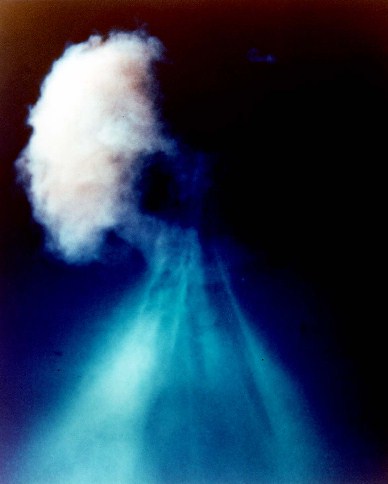
On July 19, 1957, during “Operation Plumbbob”, a nuclear armed Genie was fired from an F-89J Scorpion. From an altitude of approximately 18,000 ft, it was detonated over Yucca Flats, Nevada. With no protective gear, a group of five USAF officers and one photographer stood on the ground at ground zero to demonstrate how safe the weapon was for use over populated areas. This was the only live test ever conducted of this weapon.
The tactical plan for use of the Genie in time of war was for the F-89 to operate in tandem, upon interception of the enemy bomber formation the Genie rocket was fired from one aircraft and that plane would immediately turn away and dive to theoretically avoid the nuclear blast. The second plane would then converge on any enemy aircraft not destroyed in the explosion, but damaged or disabled from the electromagnetic pulse, and fire unguided rockets into them to finish them off.
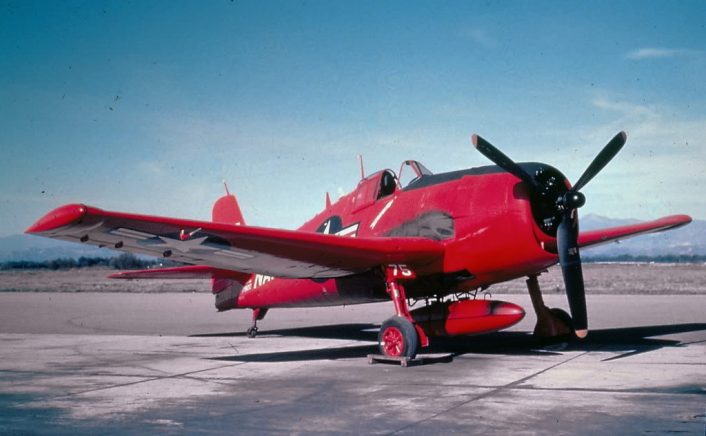
Battle Tested . . . Sort of
The F-89 Scorpion never fired any weapons in anger at an enemy, but it was involved in one peculiar incident known as “The Battle of Palmdale”.
After World War 2 had ended, the United States found itself with a surplus of obsolete aircraft. Some of these aircraft were converted to radio controlled drones for research use and as targets. One such aircraft was the Grumman F6F Hellcat.
The Hellcat had served with distinction in the U.S. Navy during the war but was no longer fit for frontline service. Converted to un-manned radio controlled drones and painted bright red or orange; they were flown off aircraft carriers and launched from air bases to be used for target practice. The bright paint jobs made them easy to spot and distinguished them as targets.
On Aug. 16, 1956, one such Hellcat drone took off from Point Mugu Naval Air Station, California. The plan was to fly the drone out over the ocean away from populated areas and test the new AIM-7 Sparrow air-to-air missile on it. However that is not what happened.
Soon after launching the drone, radio control was lost. This was not a huge issue of concern as the plane would just fly out to sea, run out of fuel, and crash. But the plane did not continue out to sea, instead turning and heading directly for Los Angeles. The Navy now had a problem, the plane might crash into a population center, and they had no fighters available to scramble to bring it down before it reached Los Angeles. A call went out to the USAF.
Two F-89D Scorpions were dispatched from nearby Oxnard Air Force Base. The two aircraft had 208 unguided 2.75 in rockets between them, and the latest electronic guidance system installed. Chasing down an unmanned propeller driven target drone and destroying it should have been a simple task. Again that is not what happened.
The two F-89’s caught up with the drone in a wide circling pattern around the city and waited for it to move away from populated areas as not to rain down debris and wreckage upon the citizens of California. When the Hellcat did move over mostly uninhabited area, one Scorpion moved in for the kill. The pilot pressed the fire button and nothing happened. Moving out of the way and allowing his wingman the opportunity, the second F-89 moved in position. Again the pilot pushed the fire button and nothing happened. The electronic fire control system had failed on both aircraft. Having the automated system and lacking guns, no manual gun sights were installed on the interceptors. The pilots would have to point their planes and fire at the drone, overriding the automated system and using the manual fire process.
The first F-89 fired a salvo of 42 rockets as the drone began to turn back towards Los Angeles. Not a single rocket hit the target. The second Scorpion fired another 42 rockets, with a couple bouncing off the Hellcat but not exploding. As the drone was approaching the town of Newhall, each interceptor made another pass firing 32 rockets each again with no hits. Now approaching Palmdale, the pilots of the Scorpions each fired the last remaining 30 rockets to no avail. Now out of ammo and low on fuel, there was nothing more the F-89 pilots could do.
The Hellcat was also low on fuel and flew on, finally crashing in a remote area taking out a few power lines but not causing much more damage than that. However, the rockets launched by the Scorpions ignited several brush fires, damaged several homes and vehicles in Palmdale, and even scored a direct hit on a parked utility truck who’s occupants had just disembarked to sit under a tree. Oil fields burned and over 1,000 acres of land was consumed, taking firefighters two days to contain the blazes. One report has a rocket shooting through a resident’s living-room window and a total of fifteen undetonated rockets were eventually found on the ground. Fortunately there were no fatalities that day.
Retirement from Service and Lessons Learned
The Northrop F-89 was retired from active service by the USAF in 1960. However, the aircraft continued duties with the ANG (Air National Guard) until 1969. The plane had stood in the gap defending the North American continent during a time of constant fear of nuclear war, filling that void until faster and more advanced aircraft came into service. The Genie rocket continued on, finding a new home in the F-106 Delta Dart and the F-101 Voodoo. The GAR-1 would be re-designated the AIM-4 (Air Interceptor Missile) in 1962.
While it may seem questionable in modern times to launch unguided nuclear rockets at enemy bombers, one must take into account the times, when almost anything seemed reasonable to protect the populace and ease their concerns. Citizens built bomb shelters in their backyards and children practiced “duck and cover” drills under their school desks. The United States Navy was developing nuclear-armed torpedoes, the Army atomic artillery and tactical missiles, and the Air Force had the Bomarc (Boeing Michigan Research Center) surface-to-air missile that could also be armed with a nuclear warhead and used against incoming bombers.
The later versions of the Scorpion were some of the first production interceptor/fighter aircraft built for the United States military without guns. The lessons of the Battle of Palmdale seemed ignored for a time, and it would take the skies over a place called Vietnam to make the American military realize the importance of arming a fighter with guns.

